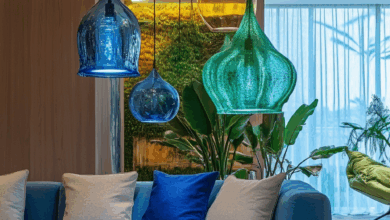13 Stunning Minimalist White Living Room Ideas to Brighten Your Space with Fresh, Airy Vibes

Designing a minimalist white living room doesn’t have to result in a cold or impersonal environment. The secret to achieving a warm yet uncluttered space lies in blending various shades of white and integrating textures that bring depth and comfort. By pairing soft ivory walls with bright white moldings and offsetting sleek surfaces with natural wood elements, you can transform your living area into a tranquil haven that exudes elegance and coziness. Here are thirteen innovative ideas to help you craft a minimalist white living room that feels fresh, inviting, and stylish.
Embrace Varied White Tones to Enhance Dimension

Transforming a stark white space into a sophisticated retreat starts with layering different whites to add visual intrigue. For instance, paint your walls in a warm ivory hue and contrast them with bright white baseboards and crown molding. Furnish the room with off-white sofas and chairs upholstered in varied fabrics like linen and velvet to introduce subtle richness. Accentuate with cream-colored cushions on pure white seating to create gentle contrasts that catch the eye. Incorporate rugs in soft bone or pearl shades to add tactile depth underfoot. This nuanced layering prevents the room from feeling flat or sterile while preserving the minimalist ethos. To further warm the palette, introduce beige accents through natural wood furniture or woven baskets, which complement the neutral scheme beautifully.
Infuse Warmth with Natural Wood Elements
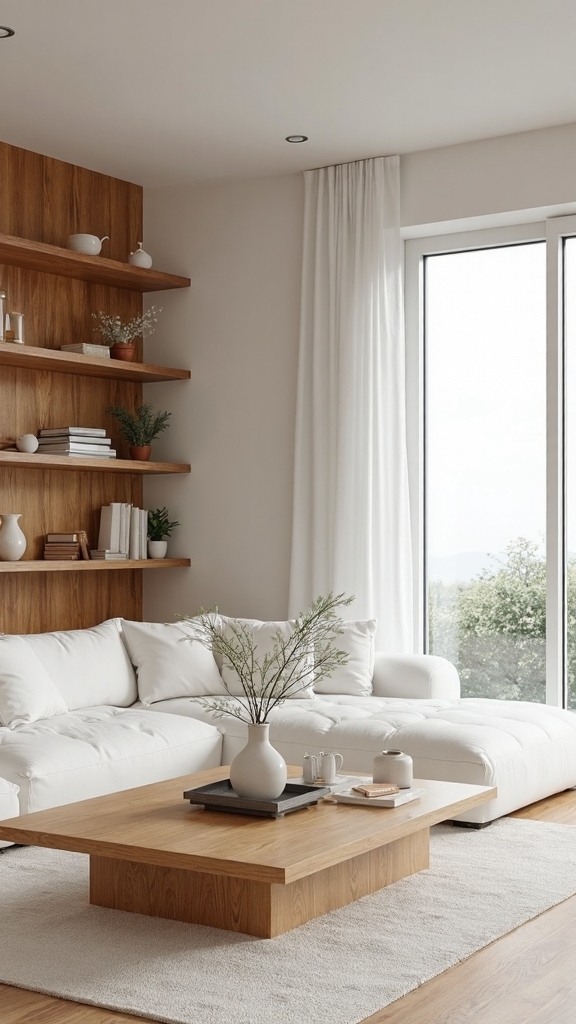
While white provides a crisp, clean backdrop, incorporating natural wood details instantly adds warmth and character to your minimalist living room. Consider a reclaimed wood coffee table as a focal point, or expose wooden ceiling beams to introduce architectural interest. Floating wooden shelves offer a sleek way to display décor without cluttering surfaces. A live-edge dining table or a wooden accent wall can create a striking contrast against white walls, grounding the space with organic textures. These elements bring a sense of nature indoors, making the room feel inviting and lived-in while maintaining minimalist simplicity. The blend of natural textures and earthy tones strikes a perfect balance between elegance and comfort.
Introduce Layered Textures with Woven Materials

Beyond wood, woven textiles add a tactile dimension that transforms a minimalist white living room into a cozy retreat. Drape chunky knit throws over streamlined sofas to create inviting contrasts against smooth surfaces. Layer natural fiber rugs made from jute or sisal beneath seating areas to anchor the space with organic warmth. Use woven baskets as both functional storage and decorative accents, placing them near reading nooks or entertainment centers. Linen curtains softly diffuse sunlight, adding gentle movement and softness to the room. This approach aligns with the Scandinavian concept of cozy minimalism, where simplicity meets comfort, ensuring your white space feels welcoming rather than stark.
Maximize Daylight with Sheer Curtains

Allowing abundant natural light to flood your living room is essential for enhancing the airy feel of a minimalist white space. Opt for sheer window treatments crafted from light fabrics such as linen voile, cotton gauze, or lightweight polyester. These materials filter sunlight gently, reducing glare while preserving brightness. Layer multiple sheer panels to add dimension and control light intensity throughout the day. Extend curtains beyond the window frame to create the illusion of larger openings. Choose crisp white or soft cream sheers that harmonize with your color palette, fostering an open, luminous atmosphere. These minimalist curtain designs enhance both the function and flow of your space.
Design a Textured Focal Wall with White Brick or Stone
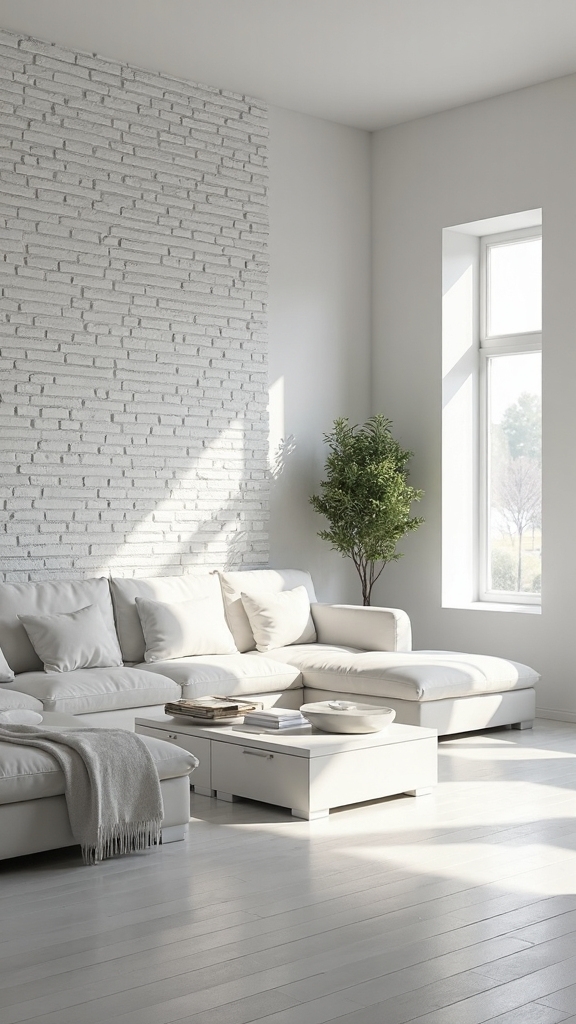
Adding a white brick or stone accent wall introduces texture and depth to your minimalist living room without disrupting its serene vibe. If you have existing brick, consider applying a whitewash finish to soften bold red tones while preserving the wall’s character. This subtle transformation adds dimension and interest without overpowering the space. Illuminate the textured surface with carefully placed wall sconces or adjustable track lighting to highlight natural patterns and create dynamic shadows throughout the day. Incorporating raw textures like exposed brick or stone complements industrial minimalist styles and reinforces clean architectural lines, elevating your room’s sophistication.
Opt for Furniture with Streamlined Profiles
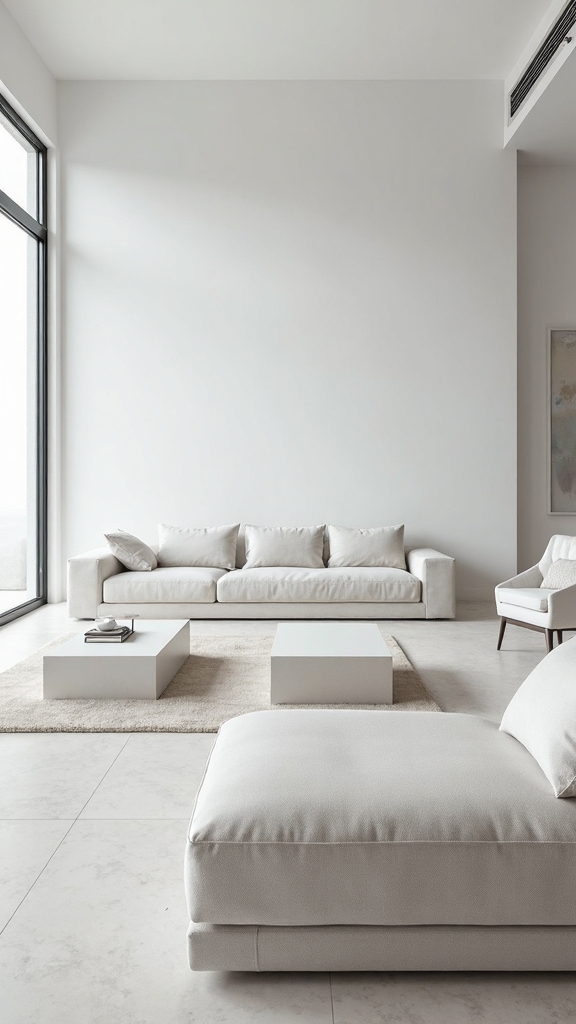
Choosing furniture with sleek, simple shapes is fundamental to maintaining a minimalist white living room that feels spacious and purposeful. Select multifunctional pieces such as ottomans with hidden compartments or coffee tables that double as workspaces to reduce clutter and maximize utility. Opt for furniture with slender legs and open bases to allow light and air to circulate freely beneath, enhancing the room’s openness. For example, a sofa with thin metal legs or a glass dining table keeps sightlines clear and the atmosphere light. Avoid bulky, overstuffed furnishings that can overwhelm the space and detract from the minimalist aesthetic.
Bring in Nature with Greenery Accents
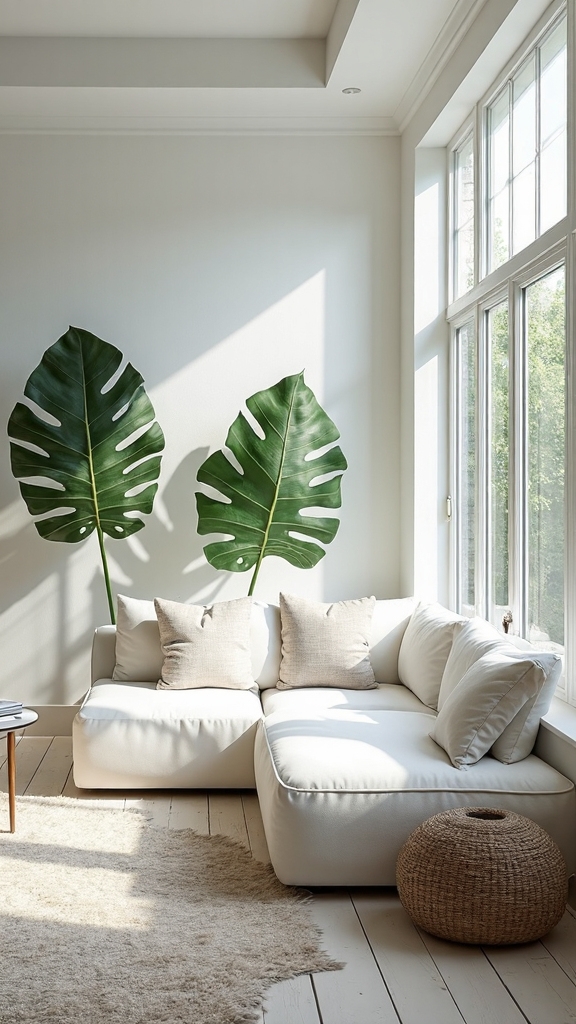
Introducing plants into your minimalist white living room adds a refreshing splash of color and life without disrupting the calm atmosphere. Choose low-maintenance floor plants like snake plants, fiddle leaf figs, or monstera deliciosa to add height and sculptural interest. For a creative touch, hang trailing plants such as pothos or string of pearls near windows or shelves to draw the eye upward and save floor space. The vibrant green hues contrast beautifully with white walls, infusing the room with vitality and a natural element that enhances the overall ambiance.
Use Mirrors to Expand Light and Space

Mirrors are a powerful tool in minimalist design, reflecting natural light and creating the illusion of a larger room. Position mirrors opposite windows to maximize daylight distribution, brightening even the darkest corners. Oversized floor mirrors leaning against walls add vertical interest without occupying surface space. Consider grouping mirrors of varying shapes and sizes at different heights to add depth and artistic flair. Choose frameless designs or thin metallic frames to maintain a sleek, uncluttered look while amplifying your room’s brightness and openness.
Select Subtle Artwork in a Neutral Palette
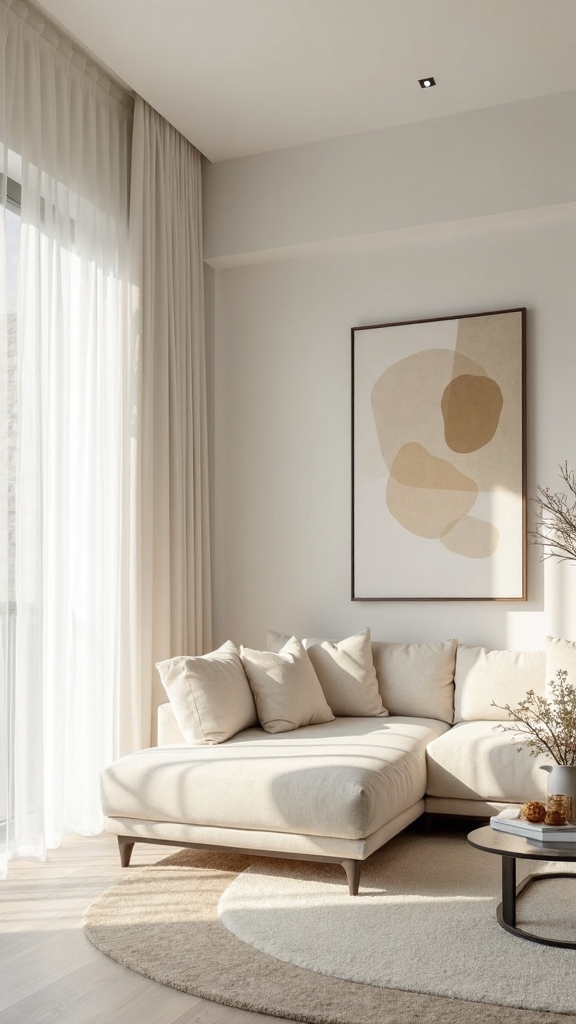
Art can enhance your minimalist white living room by adding personality without clutter. Opt for pieces in neutral tones that harmonize with your space, such as black-and-white photography or simple line drawings with ample negative space. These choices maintain the room’s airy feel while introducing visual interest. Complement wall art with minimalist sculptures or ceramics in soft creams, beiges, or muted grays displayed on floating shelves or side tables. This curated approach to décor enriches your sanctuary without detracting from its peaceful simplicity.
Layer Soft Textiles in Cream Shades
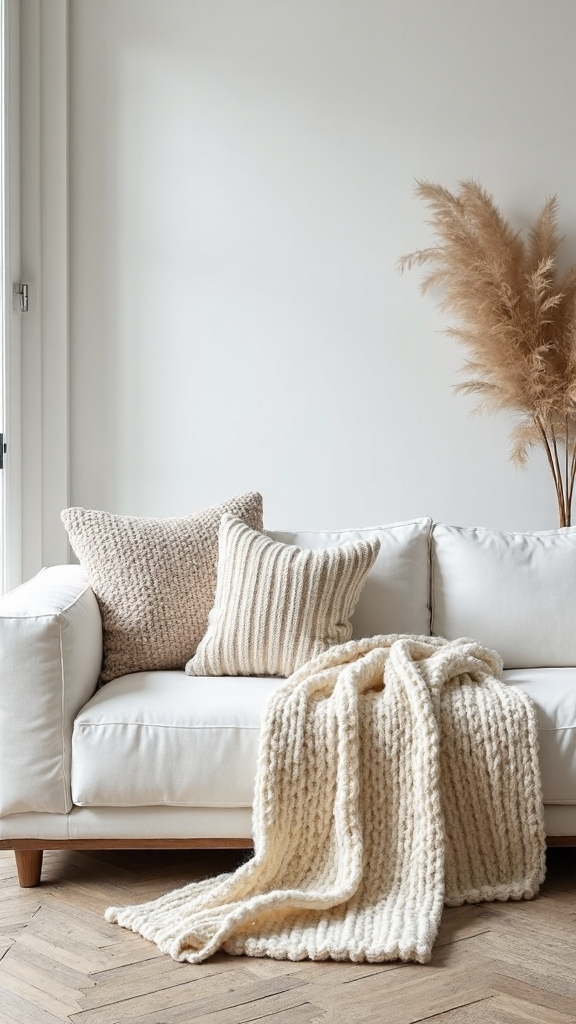
Incorporating plush textiles transforms a minimalist white living room from austere to inviting. Drape cream-colored throws over sofa arms or fold them neatly to add warmth and softness. Mix pillows in varying cream tones-from ivory to eggshell-to create subtle layers of color and texture. Combine fabrics like linen, cotton, and wool for tactile variety while preserving the minimalist aesthetic. Limit the number of pillows to three or four to avoid visual clutter, ensuring your space remains serene yet comfortable.
Integrate Concealed Storage for a Clutter-Free Space

Maintaining a clutter-free environment is crucial in minimalist design. Hidden storage solutions help keep your living room tidy without sacrificing style. Built-in cabinets with sleek white fronts blend seamlessly into walls, maximizing floor space. Ottomans with internal storage provide seating and organization for items like magazines and remotes. Wall-mounted media units conceal electronics and cables behind clean panels, preserving visual calm. Utilize under-sofa drawers to store seasonal or infrequently used belongings. These smart storage options allow you to enjoy a minimalist aesthetic while keeping essentials within easy reach but out of sight.
Enhance Architecture with Built-In Shelving
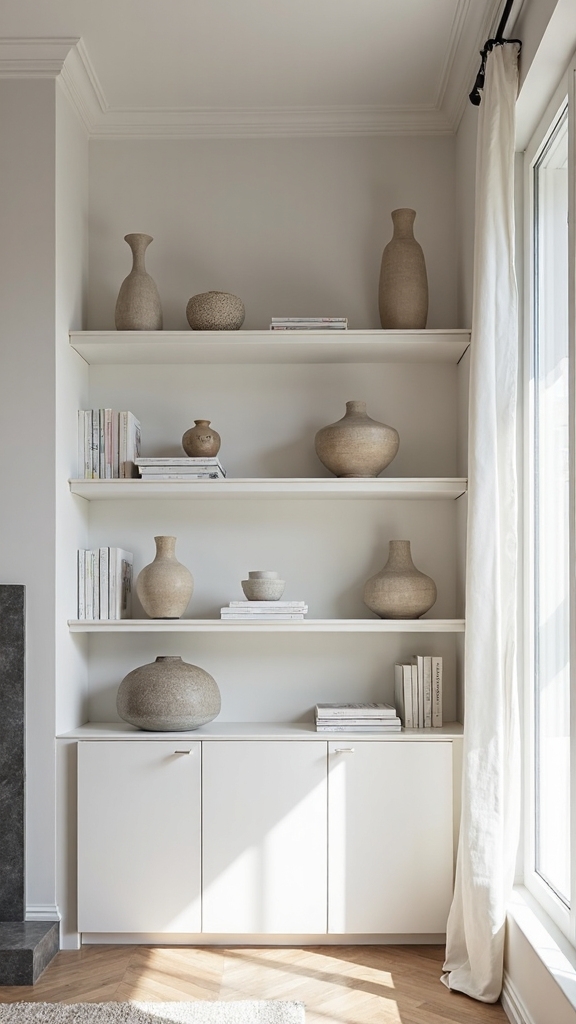
Built-in shelving elevates your minimalist white living room by adding architectural interest and functional display space. Floating shelves reduce the need for bulky furniture, allowing you to showcase curated décor without overwhelming the room. Arrange shelves at varying heights to break up wall monotony and create visual rhythm. Recessed cabinetry integrates storage into walls, preserving open floor plans and enhancing the room’s sleek design. These elements contribute to a thoughtfully designed space that balances form and function.
Balance Cool Whites with Warm Lighting

Lighting plays a pivotal role in softening the crispness of white walls and creating a welcoming atmosphere. Incorporate warm-toned fixtures such as brass pendant lamps, amber-hued table lamps, or wooden floor lamps to introduce golden warmth against the cool white backdrop. Layer lighting at different levels-overhead, mid-height sconces, and low accent lamps-to add depth and dimension. Choose lampshades made from woven materials or linen to cast gentle shadows and enhance texture. This lighting strategy transforms a stark white room into a cozy, sophisticated retreat without compromising minimalist principles.
Final Thoughts on Creating a Minimalist White Living Room
With these design techniques, you’re equipped to craft a minimalist white living room that is both practical and inviting. Begin by layering diverse white shades, then introduce natural wood and textured fabrics to add warmth. Maximize natural light with sheer curtains and incorporate clever storage solutions to maintain order. By blending these elements thoughtfully, you’ll create a bright, airy space that perfectly balances simplicity with comfort and visual appeal.



